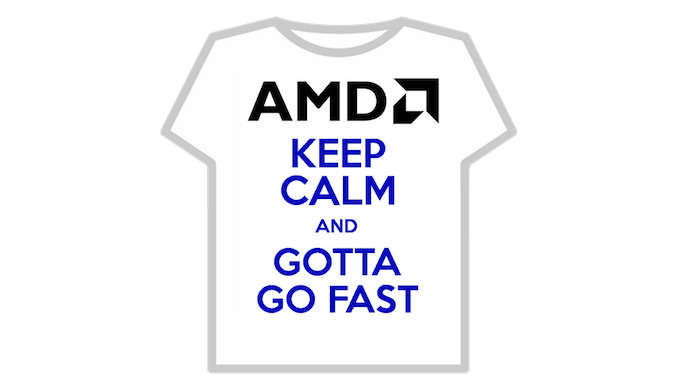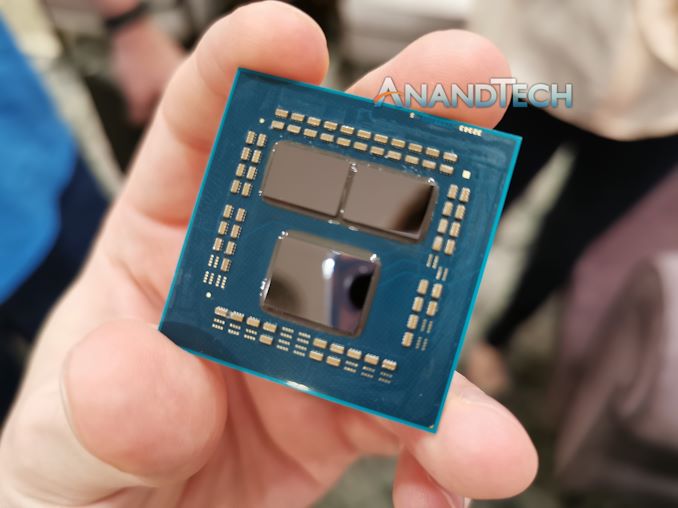Reaching for Turbo: Aligning Perception with AMD’s Frequency Metrics
by Dr. Ian Cutress on September 17, 2019 10:00 AM EST
For those that keep a close eye on consumer hardware, AMD recently has been involved in a minor uproar with some of its most vocal advocates about the newest Ryzen 3000 processors. Some users are reporting turbo frequencies much lower than advertised, and a number of conflicting AMD partner posts have generated a good deal of confusion. AMD has since posted an update identifying an issue and offering a fix, but part of all of this comes down to what turbo means and how AMD processors differ from Intel. We’ve been living on Intel’s definitions of perceived standards for over a decade, so it’s a hard nut to crack if everyone assumes there can be no deviation from what we’re used to. In this article, we’re diving at those perceived norms, to shed some light on how these processors work.
A Bit of Context
Since the launch of Zen 2 and the Ryzen 3000 series, depending on which media outlet you talk to, there has been a peak turbo issue with the new hardware. This turbo frequency issue has been permeating in the ecosystem since Zen 2 was launched, with popular outlets like Gamers Nexus noting that on certain chips, the advertised turbo frequency was only achieved under extreme cooling conditions. For other outlets, being within 50 MHz of the peak turbo frequency has been considered chip-to-chip variation, or a function of early beta firmware. A wide array of people put varying amounts of weight behind this, from conspiracy to not being bothered about it at all.
However, given recent articles by some press, as well as some excellent write-ups by Paul Alcorn over at Tom’s Hardware*, we saw that the assumed public definitions of processor performance actually differs from Intel to AMD. What we used as the default standard definitions, which are based on Intel’s definitions, are not the same under AMD, which is confusing everyone. No one likes a change to the status quo, and even with articles out there offering a great breakdown of what's going on, a lot of the general enthusiast base is still trying to catch up to all of the changes.
This confusion – and the turbo frequency discussion in general – were then brought to the fore of news in the beginning of September 2019. AMD, in a two week span, had several things happen essentially all at once.
- Popular YouTuber der8aur performed a public poll of frequency reporting that had AMD in a very bad light, with some users over 200 MHz down on turbo frequency,
- The company settled for $12.1m in a lawsuit about marketing Bulldozer CPUs,
- Intel made some seriously scathing remarks about AMD performance at a trade show,
- AMD’s Enterprise marketing being comically unaware of how its materials would be interpreted.
Combined with all of the drama that the computing industry can be known for – and the desire for an immediate explanation, even before the full facts were in – made for a historically bad week for AMD. Of course, we’ve reported on some of these issues, such as the lawsuit because they are interesting factoids to share. Others we ignored, such as (4) for a failure to see anything other than an honest mistake given how we know the individuals behind the issues, or the fact that we didn’t report on (3) because it just wasn’t worth drawing attention to it.
What has driven the discussion about peak turbo has come to head because of (1). Der8auer’s public poll, taken from a variety of users with different chips, different motherboards, different cooling solutions, different BIOS versions, still showed a real-world use case of fewer than 6% of 3900X users were able to achieve AMD’s advertised turbo frequency. Any way you slice it, without context, that number sounds bad.
Meanwhile, in between this data coming out and AMD’s eventual response, a couple of contextual discrepancies happened between AMD’s partner employees and experts in the field via forum posts. This greatly exacerbated the issue, particularly among the vocal members of the community. We’ll go into detail on those later.
AMD’s response, on September 10th, was a new version of its firmware, called AGESA 1003-ABBA. This was released along with blog post that detailed that a minor firmware issue was showing 25-50 MHz drop in turbo frequency was now fixed.
Naturally, that doesn’t help users who are down 300 MHz, but it does come down to how much the user understands how AMD’s hardware works. This article is designed to shed some light on the timeline here, as well as how to understand a few nuances of AMD's turbo tech, which are different to what the public has come to understand from Intel’s use of specific terms over the last decade.
*Paul’s articles on this topic are well worth a read:
Ryzen 3000, Not All Cores Are Created Equal
Investigating Intel’s Claims About Ryzen Reliability
Testing the Ryzen 3000 Boost BIOS Fix
This Article
In this article we will cover:
- Intel’s Definition of Turbo
- AMD’s Definition of Turbo
- Why AMD is Binning Differently to Intel, relating to Turbo and OC
- A Timeline of AMD’s Ryzen 3000 Turbo Reporting
- How to Even Detect Turbo Frequencies
- AMD's Fix











144 Comments
View All Comments
StrangerGuy - Wednesday, September 18, 2019 - link
Pretty much the only people left OCing CPUs are epeen wavers with more money than sense."$300 mobo and 360mm AIO for that Intel 8 core <10% OC at >200W...Look at all that *free* performance! Amirite?"
Korguz - Wednesday, September 18, 2019 - link
" Pretty much the only people left OCing CPUs are epeen wavers with more money than sense" that a pretty bold statement. i know quite a few people who overclock their cpus, because intel charged too much for the higher end ones, so they had to get a lower tier chip. with zen, thats not the case as much any more as they have switched over to amd, because by this time, they would of had to get a new mobo any way, because intels upgrade paths are only 2, maybe 3 years if they are lucky.dont " need " and AIO, as there are some pretty good air coolers out there, and some, dont like the idea of water, or liquid in their comps :-)
Xyler94 - Thursday, September 19, 2019 - link
Sorry, here's where I'll have to disagree with you.You'll never overclock an i3 to i5/i7 levels. If my choices were between an overclocking i3, with a Z series board, or a locked i5 with an H series board, I'd choose the i5 in a heartbeat, as that's just generally better. Overclocking will never make up the lack of physical cores.
So I agree, mostly these days overclocking is reserved for A: People with e-peens, and B:, people who genuinely need 5ghz on a single core... which are fewer than those who can utilize the multi-threaded horsepower of Ryzen... so yeah,
evernessince - Tuesday, September 17, 2019 - link
Does it deliver well? I see plenty of people on the Intel reddit not hitting advertised turbo speeds. That's considering they are using $50+ CPU coolers as well."Pretty impressive to see a server cpu with 20% lower ST performance only because the
low power process utilized is unable to deliver a clock speed near 4Ghz, absurd thing considering
that Intel 14nm LP gives 4GHz at 1V without struggles."
What CPU are you talking about? Even AMD's 64 core monster has damn near the same IPC as the Intel Xeon 8280 (thanks to Zen 2 IPC improvements) and that CPU has LESS THEN HALF THE CORES and only consumes 20w more. The Intel CPU also costs almost twice as much. Only a moron brings up single threaded performance in a server chip conversation anyways, it's one of the least important metric for server chips. AMD's new EPYC chip crushes Intel in Core count, TCO, power consumption, and security. Everything that is important to server.
yankeeDDL - Wednesday, September 18, 2019 - link
You do realize that the clock speed does not depend only by the process, right? Your comment sounds like that that of a disgruntled Intel fanboy trying to put AMD in under a bar light. For 25MHz.Spunjji - Monday, September 23, 2019 - link
Absolute codswallop. AMD are getting 100-300Mhz more on their peak clock speeds for Zen2 with this first-gen 7nm process tech than they were seeing with Zen+ 12nm (and nearly 400Mhz more than Zen on 14nm), so nothing about that implies that 7nm is slower than 14nm. Intel's architecture and process tech are not remotely comparable to AMD's, and we don't know what is the primary limiting factor on Zen clockspeeds.Not sure why you're claiming lower ST performance on the server parts either - Rome is better in every single regard than its predecessors, and it's better pound-for-pound than anything Intel will be able to offer in the next 12-18 months.
PeachNCream - Tuesday, September 17, 2019 - link
I see a tempest in a teapot on the stove of a person who is busy splitting hairs at the kitchen table. It would be more interesting to calculate how much energy and time was expended on the issue to see if the performance uplift from the fix will offset the global societal cost of all the clamoring this generated. For that, I suppose you'd have to know how many Ryzen chips are actually doing something productive as opposed to crunching at video games.The idea of buying cheaper hardware for non-work needs sticks here. Less investment means less worry about maximizing your return on your super-happy-fun-box and less heartburn over a little bit of clockspeed on a component that plays second fiddle to GPU performance when it comes to entertainment anyway.
psychobriggsy - Tuesday, September 17, 2019 - link
Ultimately in the end it isn't MHz that counts, it is observed performance in the software that you care about. That's why we read reviews, and why the review industry is so large.If performance X was good enough, does it matter if it was achieved at 4.5GHz or 4.425GHz? Not really. But if the CPU manufacturer is using it as a primary competitive comparison metric (rather than a comparative metric with their other SKUs) then it has to be considered, like in this article.
It is sad that MHz is still a major metric in the industry, although now Intel IPC is similar to AMD IPC, it is actually kinda relevant.
What I'd like is better CPU power draw measurements versus what the manufacturer says. Because TDP advertising seems to be even more fraught with lies/marketing than MHz marketing! Obviously most users don't care about 10 or 20% extra power draw at a CPU level, as at a system level it will be a tiny change, but it's when it is 100% that it matters.
IMO, I'd like TDPs to be reported at all core sustained turbo, not base clocks. Sure, have a typical TDP measurement as well as the more information the better, but don't hide your 200W CPU under a 95W TDP.
TechnicallyLogic - Tuesday, September 17, 2019 - link
Personally, I feel that AMD should have 2 numbers for the max frequency of the CPU; "Boost Clock" and "Burst Clock". Assuming that you have adequete cooling and power delivery, the boost clock would be sustainable indefinitely on a single core, while the burst clock would be the peak frequency that a single core on the CPU can reach, even if it's just for a few ms.fatweeb - Tuesday, September 17, 2019 - link
I could see them eventually going in this direction considering Navi already has three clocks: Base, Gaming, and Boost. The first two would be guaranteed, the last not so much.